Linguine alle Vongole
Linguine alle Vongole is a classic pasta dish where linguine noodles are tossed with fresh clams, garlic, white wine, and lemon. It’s a satisfying but light dinner, with incredible flavor!
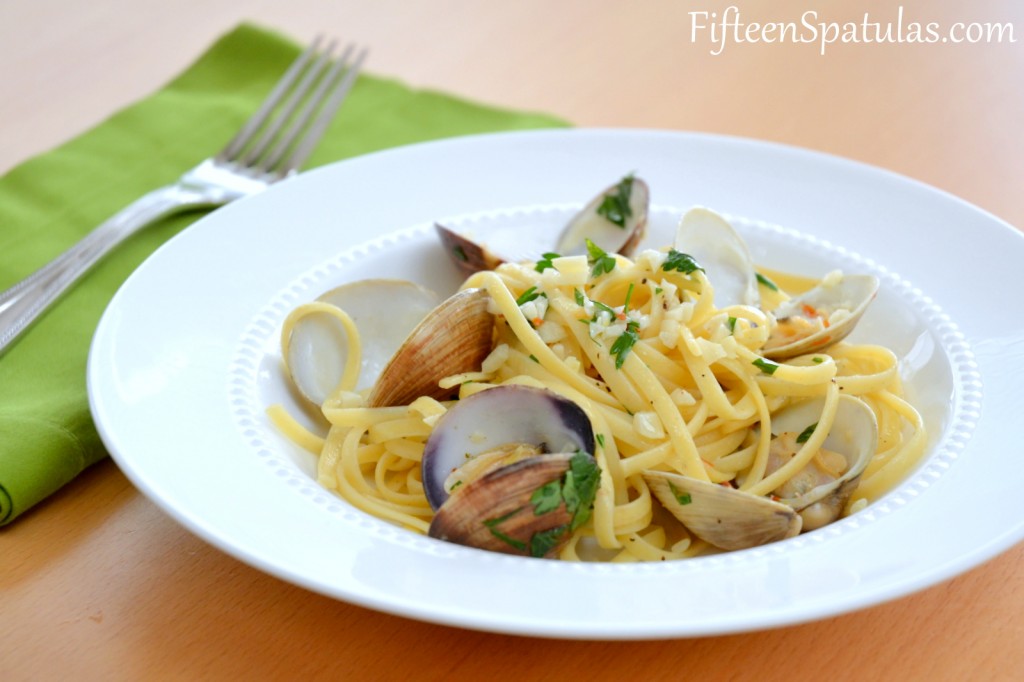
If you’ve never had it before, Linguine alle Vongole is a dish that can take you by surprise.
I remember the first time I tried it, when I was working at an Italian restaurant in my hometown in my teenage years.
Because it didn’t really have a sauce, or at least, wasn’t thickly coated in tomato sauce or alfredo sauce like most of the other dishes we served, I didn’t expect it to have SO MUCH FLAVOR.
But that is the power of the ingredients used. It may not have the richness of the egg yolk sauce in Spaghetti Carbonara, but what it has instead is the perfect collection of flavorful ingredients.
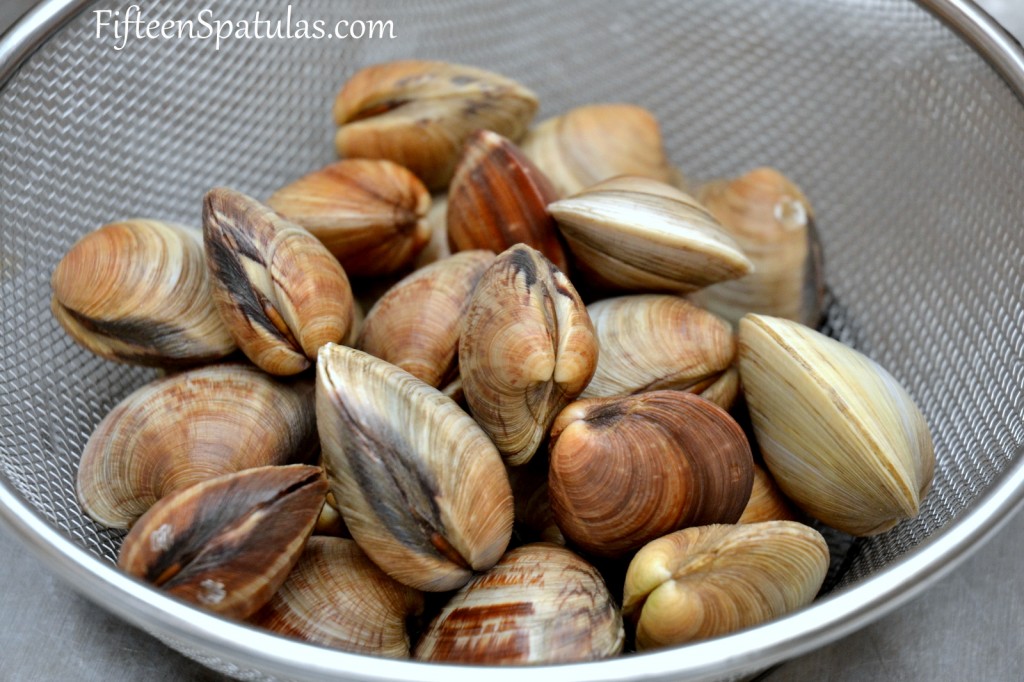
The clams are pleasingly salty and briney, the garlic is fragrant, the white wine adds a complexity of taste and aroma, the olive oil a peppery richness, and the parsley adds an earthy, herbaceous element to the dish.
There’s not a lot of ingredients here, but each brings something important to the table, making for an incredibly delicious dish.
Tips for Best Results
Use fresh clams – Some people will make Linguine alle Vongole with canned clams, and though I understand the convenience factor, canned clams will never compare to fresh clams. Treat yourself to the good stuff here.
Select the appropriate wine – Some white wines can be very sweet, and you’ll want to stay away from those here. I recommend white wines on the dry side. I’ve had good success with Pinot Grigio and Chenin Blanc. Sauvignon Blanc can work well too.
Do not overcook the pasta – Take care not to boil the pasta so much that the noodles become soft and mushy. Follow instructions on the package for “al dente” but make sure to double check by actually tasting the noodles at the end of cooking. Remember that the linguine will cook slightly more after leaving the water, so undercook slightly.
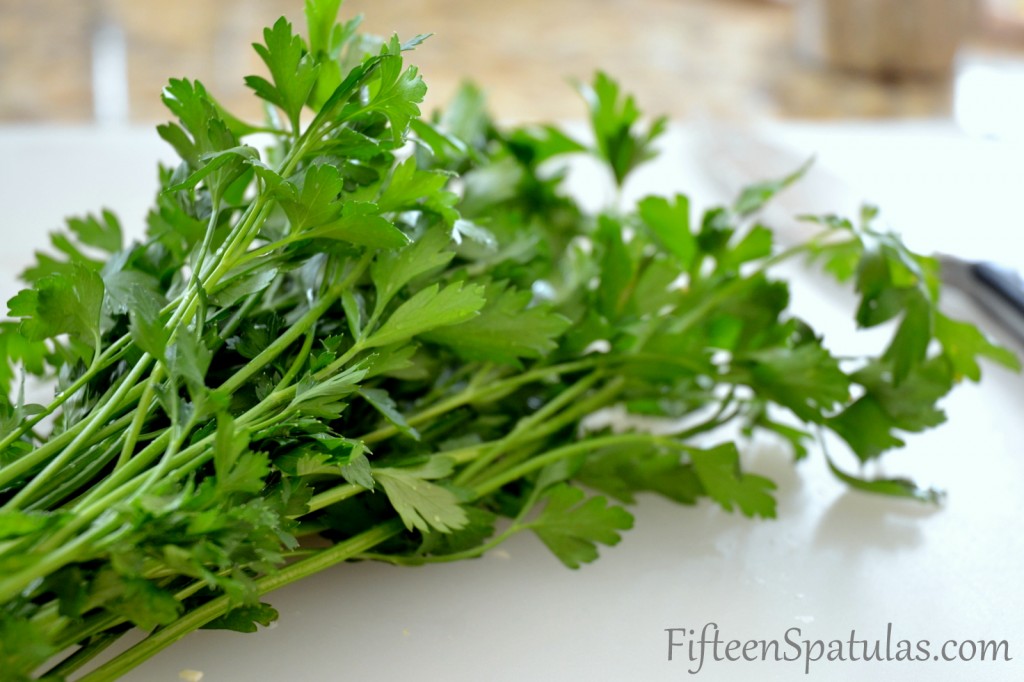
The first thing to do is decide whether or not you need to soak the clams.
Some people say that if the clams are farm raised, it’s not necessary. Even if the clams I purchase are farm raised, personally I like to soak them anyway, because gunk always seems to come out.
What kind of clams should you use?
I like to use littleneck clams, though manila clams are also great if you can find them. At my grocery store they are priced per piece, so I buy larger instead of small clams based on price, but you may use whichever you prefer.
Always start by sorting the clams, and throwing out any that are chipped:
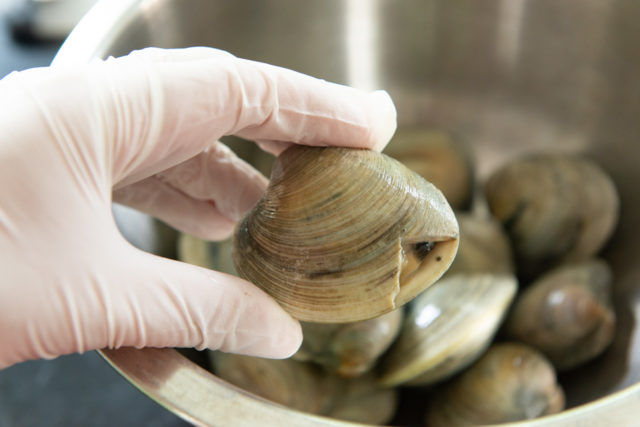
Then I like to rinse the shells under running water, and use a sturdy paper towel, sponge, or brush to clean away any mud or debris on the outside of the shells:
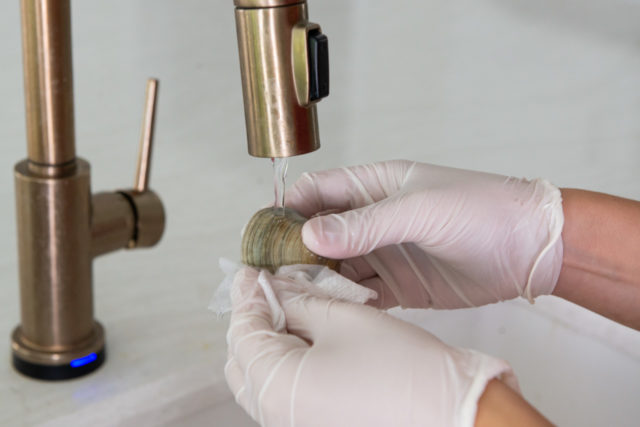
Next, I soak the clams in salt water to allow them to purge any sand or gunk inside. I have the exact instructions in my How to Clean Clams post.
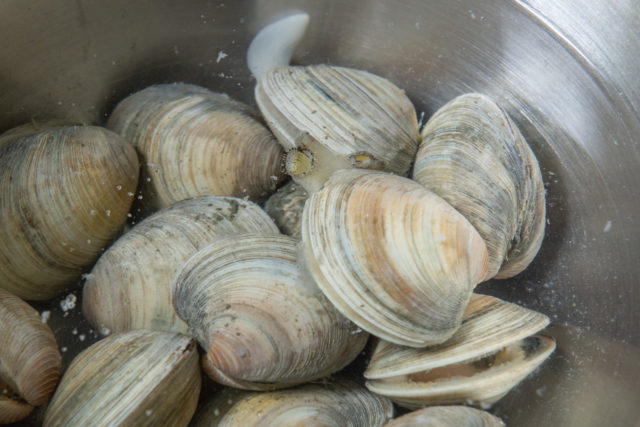
You can see below that even the farm raised live clams can purge some gunk inside:
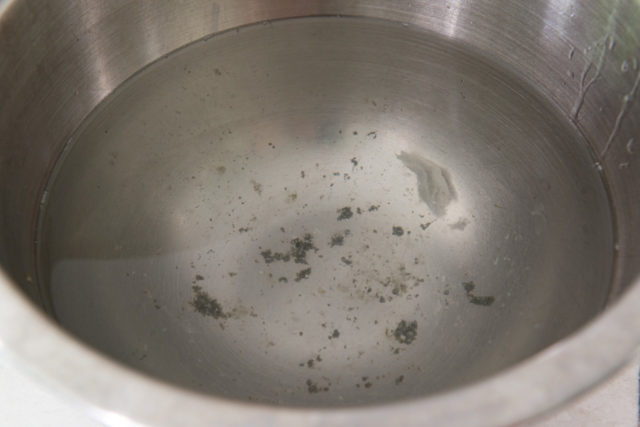
Once the clams are all prepped, it’s just a matter of cooking them in heaps of minced garlic cloves, white wine, red pepper flakes, clam juice, and fresh lemon in a large skillet.
I start by briefly sauteing the aromatics over medium heat, then adding the clams and remaining ingredients and cooking over medium-high heat. Make sure to throw out any unopened clams, as this indicates they were already dead before cooking.
Then add cooked linguine noodles to that pan, pulling the noodles straight from the boiling water. Not rinsing the pasta lets the starch thicken the white wine sauce a bit.
Finally, I finish the pasta alle vongole with lots of fresh chopped parsley.
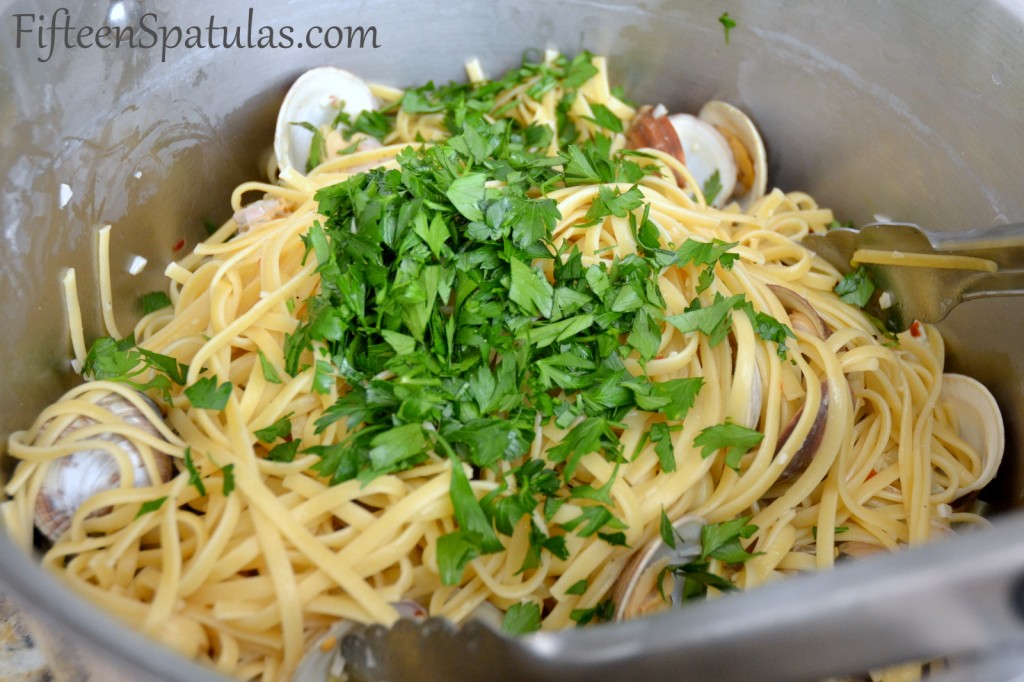
A touch of lemon zest can also be nice to echo the lemon juice, but is definitely optional. I also put a bottle of good quality extra virgin olive oil on the table in case anyone wants extra on top.
Because the briny clams are so salty, you likely will not need to season with extra kosher salt at the end. If the pasta tastes too salty for your liking, add a squeeze of fresh lemon juice. Its acidity will balance out the salt. Enjoy!
How to Serve
Once you’ve tossed in the fresh parsley, serve the Linguine alle Vongole immediately. As the linguine noodles cool, they will absorb the liquid, so you want to enjoy while everything is hot.
While I don’t think this seafood pasta necessarily needs a side, I like to place a salad on the table as well. A Caesar Salad is great here, as well as Tomato Burrata Salad, Kale Salad, and Zucchini Ribbon Salad.
Recipe Variations
Linguine vongole is a pretty standard Italian clam pasta, and I would not deviate much from this recipe. However, here are a few adjustments you can make.
Noodle type – You may certainly make this spaghetti alle vongole, or use whatever type of noodle or pasta you prefer. Just follow the cook time on the package instructions for al dente.
Cherry tomatoes – Throw in a cup or two of halved cherry tomatoes at the very end.
Pepper – If crushed red pepper flakes are too spicy for your tastes, you may simply use black pepper, or no pepper at all.
Recipe Tips and FAQ
Keep in an airtight container in the fridge for up to 3 days.
Technically yes, in an airtight container for up to 2 months, but know that it’s far inferior upon thawing because so much of that fresh and bright flavor is lost. To thaw, leave in the fridge overnight.
I recommend removing the clams from the shells first, then microwave in 30-second intervals at 70% power until warmed through.
Did you enjoy the recipe? Please leave a 5-star rating in the recipe card below and/or a review in the comments section further down the page. Or, follow me on Facebook, Instagram or Pinterest!
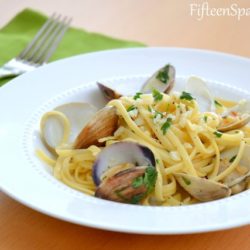
Linguine alle Vongole
Ingredients
- 1 lb linguine
- 2 dozen littleneck clams* cleaned and maybe soaked (see note)
- 2 tbsp olive oil
- 2 tbsp salted butter
- 3 tbsp minced garlic
- 1/4 tsp red pepper flakes
- 1/4 cup white wine**
- 1/4 cup clam juice
- 2 tbsp lemon juice
- 1/4 cup chopped parsley
- salt
- black pepper
Instructions
- You want to time this dish so that the pasta *just* finishes cooking to al dente right when the clams and sauce are ready. Read all instructions before you begin cooking.
- Bring a big pot of salted*** water to a boil in preparation for cooking the linguine noodles.
- Get a large skillet that has a lid, and place the olive oil, butter, garlic, and red pepper flakes in the pan. Heat over medium heat for 2 minutes, until it smells fragrant.
- Add the white wine, clam juice, and lemon juice and raise the heat to medium high. Add the clams and cover the pan. Cook for about 5 minutes, until the clams open (if the clams don’t open, you can cook them for another couple minutes, but if they don’t open at all, throw them out, since this means they were dead before cooking).
- Begin cooking the linguine to al dente in the big pot of salted water, according to package directions. Cook time is usually about 9 minutes, but can vary by brand.
- When the clams have opened, remove them to a plate using a slotted spoon, and bump the heat up to high. Reduce the cooking liquid for a few minutes, until you have about 3 tbsp of liquid remaining.
- The linguine should be just about done by now. Use tongs to add the noodles directly from the water to the clam sauce pan (the starchy water that comes with the noodles will help create a sauce). Toss to coat, add the clams back in, and throw in the parsley. Season with pepper, to taste. Enjoy while hot!
Notes
Nutrition
Nutrition is estimated using a food database and is only intended to be used as a guideline for informational purposes.

15 Comments on “Linguine alle Vongole”
Excellent recipe, the wine and lemon juice were a perfect combination to make this dish very flavorful and bright. I used a mix of manila and Venus clams, I also included a pack of clams to the sauce for added protein and a shredded carrot for color and sweetness. My family loved it!
Thank you.
DELISH…THIS IS HOW I MAKE MINE AS WELL
I used this recipe today with 18 little necks and I also added one can of Cento Clam sauce to the other ingredients in the pan. This was better than any I have ever had in any restaurant! Hubby LOVED it too and he is really fussy. Soaking the clams in the salted water for 30 min. really gave them a lot of flavor. I used sea salt. This is a keeper! I can’t wait to make this scrumptious dish again. I have tried other recipes like this in the past but they were never this good.
YAY! That’s wonderful Barbara. So glad to hear that you both loved it so much!
Beautiful bowl of pasta! I love clams and pasta and this looks like a fabulous recipe!
Wow, you’re so young. Minimum wage was like a quarter when I was in high school. Also, this is such a classic recipe and your photos are stellar.
Oops forgot to check the email box
This sounds so tasty and simple. I will definitely try this.
I feel bad I haven’t been by but just realized that I’m signed up with you as WordPress.com and now you are just .com so I’m rejoining in hopes to get your posts sent to me.
Beautiful photos as always.
I love this pasta looks so simple but I know its so flavourful, I love clams in every cooking and use that always to make seafood stocks, such a strong seafood
Sounds like a wonderful dinner to enjoy with a bottle of white wine.
hope you’re having a great weekend.
What a beautiful simple dish! Sometimes it’s the simple things that make life so grand. This dish is one of them.
Bravo…bravo…I like so much the pasta with sea food, and living in the coast is very easy for us to find fresh sea food. We are very close to the Easter holidays, on Friday we cannot eat meat, so this pasta will come perfect for us.
Oh Joanne, you are making my mouth water in such a HUGE way. I love this linguine dish. It seems so light but so good
That’s really the best way to learn…I learned everything I know now from my mom, brother and working as the demo cook at Williams Sonoma, and getting tips from the full time chefs there. And I’m definitely still learning! There’s always more to know. This pasta sounds so delicious, love the sauce. 🙂
Simple and delicious and great presentation, my kind of dish.